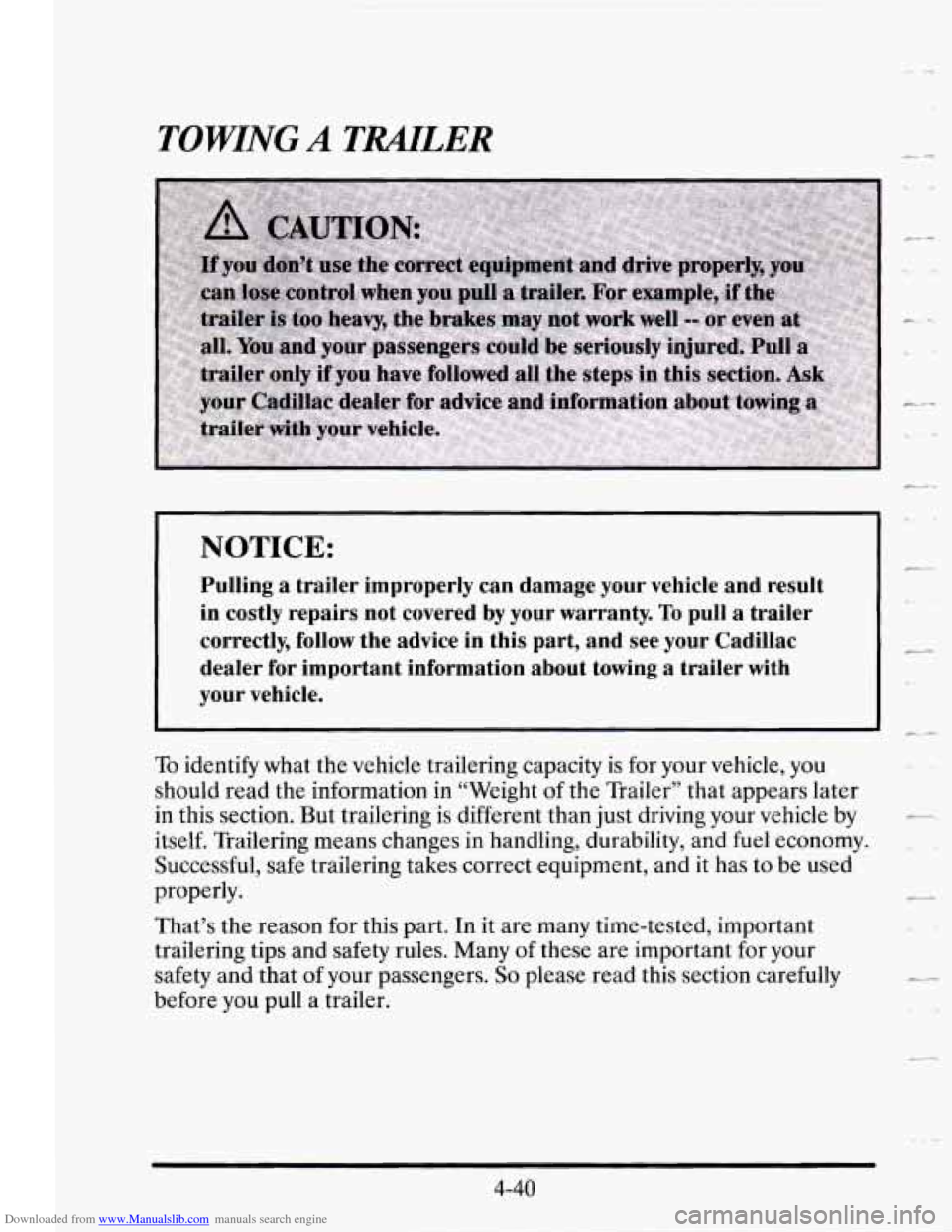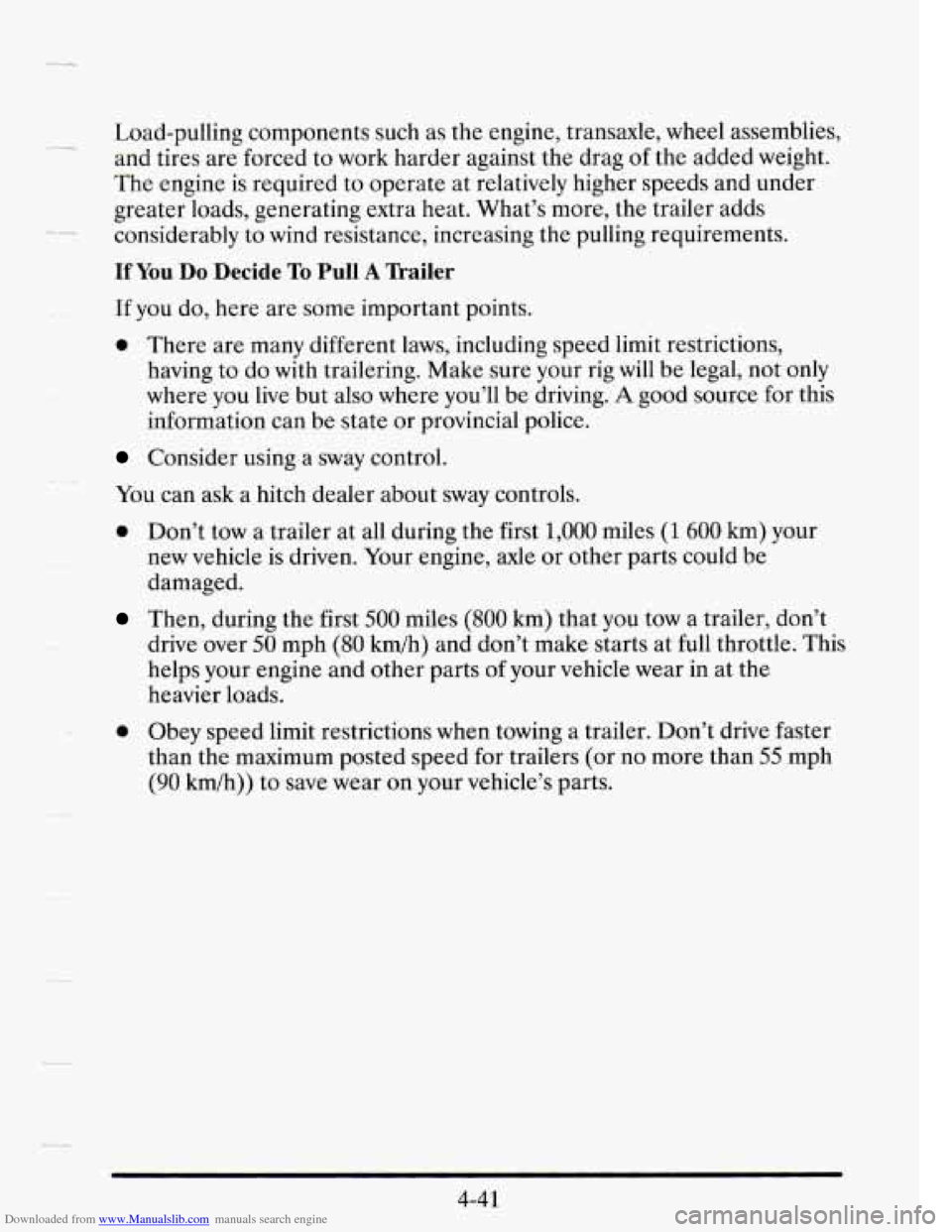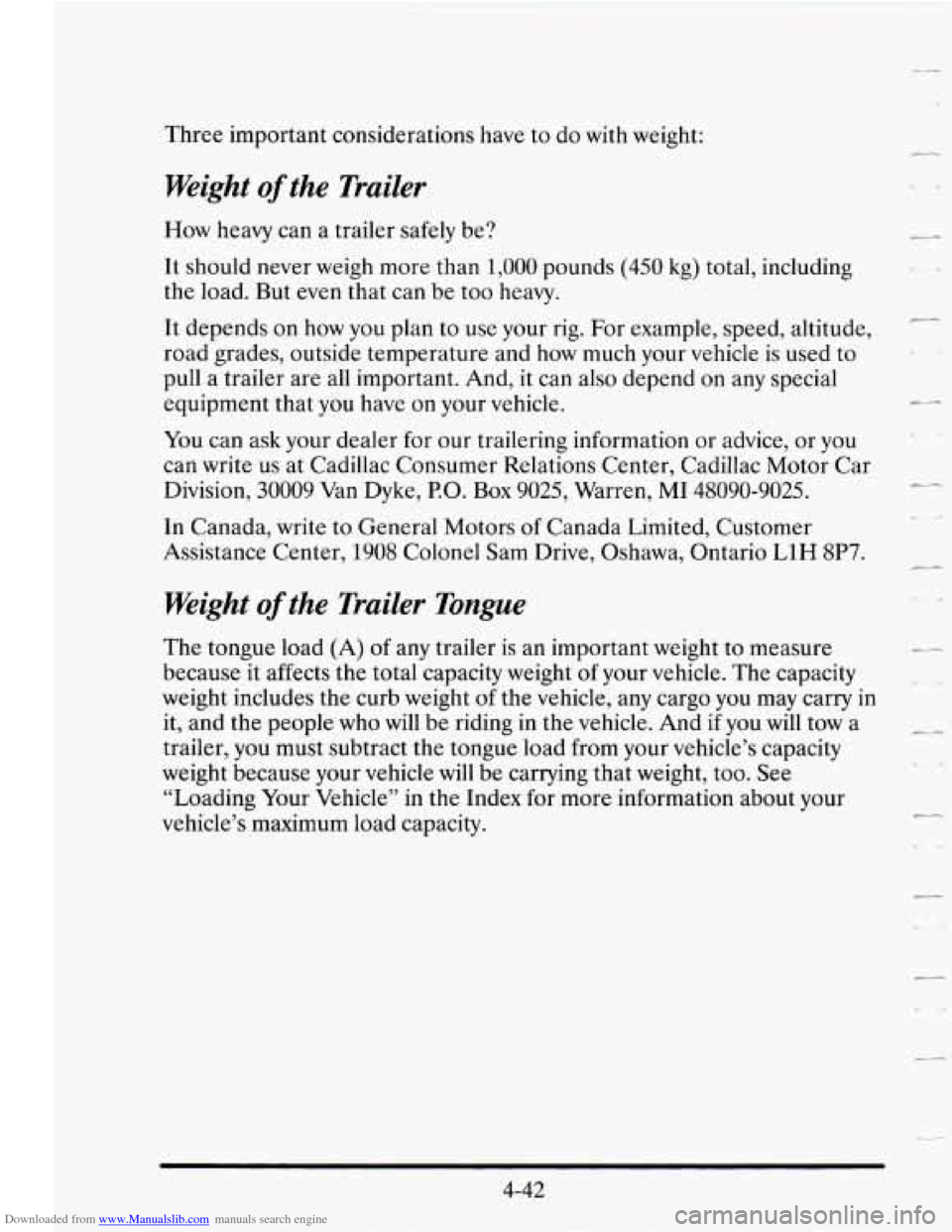Page 90 of 410

Downloaded from www.Manualslib.com manuals search engine If you’re ever driving and you get the PASS-KEY MALFUNCTION
message you
will be able to restart your engine if you turn it off. Your
PASS-Key@II system, however, is not working properly and must be
serviced by your Cadillac dealer.
Your vehicle is not protected by the
If you lose or damage a PASS-Key@II ignition ke , see your Cadillac
dealer
or a locksmith who can service PASS-Key I1 to have a new key
-
PP PASS-Key@II system.
8
- made.
NEW WHICLE t4BREM-IN”
NOTICE:
Your modern Cadillac doesn’t need an elaborate “break-in.” But
it will perform better in the long run
if you follow these
guidelines:
Don’t drive at any one speed -- fast or slow -- for the first
500 miles (804 km). Don’t make full-throttle starts.
0 Avoid making hard stops for the first 200 miles (322 km) or
so. During this time your new brake linings aren’t yet broken
in. Hard stops with new linings can mean premature wear
and earlier replacement. Follow this “breaking-in” guideline
every time you get new brake linings.
Don’t tow a trailer during “break-in.” See “Towing a Bailer”
in the Index for more information.
2-19
Page 98 of 410

Downloaded from www.Manualslib.com manuals search engine AUTOMATIC OVERDRIVE (@): This position is for normal driving. If
Going less than 35 mph (55 kmih), push your accelerator pedal about
Going about 35 mph (55 km/h) or more, push the accelerator all the
- you need more power for passing, and you’re:
halfway down.
way down.
c_
The transaxle will shift down to the next gear and have more power.
NOTICE:
If your vehicle seems to start up rather slowly, or if it doesn’t
seem to shift gears as you accelerate, something may be wrong
with
a transaxle system sensor. If you drive very far that way,
your vehicle can be damaged. So if this happens, have your
vehicle serviced right
away. Until then, you can use SECOND (2)
when you are driving less than 35 mph (55 km/h) and
AUTOMATIC
OVERDRIVE (@) for higher speeds.
.-. -
THIRD (3): This position limits upshifting and will not allow you to shift
into AUTOMATIC OVERDRIVE
(@).
Here are examples for using THIRD (3) instead of AUTOMATIC
OVERDRIVE
(@):
When driving on hilly, winding roads.
When towing a trailer, so there is less shifting between gears.
0 When going down a steep hill.
2-27
Page 101 of 410
Downloaded from www.Manualslib.com manuals search engine I
NOTICE:
I- Driving with the parking brake on can cause your rear brakes \
to
overheat. You may have to replace them and you could also
damage other parts
of your vehicle. -. -
If you are towing a trailer and are parking on a hill, see “Towing a Trailer”
in the Index. This section shows what to do first to keep the trailer from
moving. c4
SHIFTING INTO PARK (P) c4
2-30
F-
Page 108 of 410
Downloaded from www.Manualslib.com manuals search engine RUNNING YOUR ENGINE WHILE YOU’RE
P-D
It’s better not to park with the engine running. But if you ever have to,
here are some things to know.
Follow the proper steps to be sure your vehicle won’t move.
See “Shifting
Into
PARK (P)” in the Index.
If you are parking on a hill and if you’re pulling a trailer, also see “Towing
a Trailer” in the Index.
2-37
Page 231 of 410

Downloaded from www.Manualslib.com manuals search engine TOWING A TMLER c-
NOTICE:
Pulling a trailer improperly can damage your vehicle and result
in costly repairs not covered by your warranty. To pull a trailer
correctly, follow the advice
in this part, and see your Cadillac
dealer for important information about towing a trailer with
your vehicle.
To identify what the vehicle trailering capacity is for your vehicle, you
should read the information in “Weight
of the Trailer” that appears later
in this section. But trailering
is different than just driving your vehicle by
itself. Trailering means changes in handling, durability, and fuel economy.
Successful, safe trailering takes correct equipment, and it has
to be used
properly.
That’s the reason for this part.
In it are many time-tested, important
trailering tips and safety rules. Many
of these are important for your
safety and that
of your passengers. So please read this section carefully
before you pull
a trailer.
4-40
c-
Page 232 of 410

Downloaded from www.Manualslib.com manuals search engine Load-pulling components such as the engine, transaxle, wheel assemblies,
and tires are forced to work harder against the drag
of the added weight.
The engine is required to operate at relatively higher speeds and under
greater loads, generating extra heat. What’s more, the trailer adds
considerably to wind resistance, increasing the pulling requirements.
If You Do Decide To Pull A mailer
If you do, here are some important points.
0 There are many different laws, including speed limit restrictions,
having
to do with trailering. Make sure your rig will be legal, not only
where you live but also where you’ll be driving.
A good source for this
information can be state or provincial police.
Consider using a sway control.
You can ask a hitch dealer about sway controls.
0 Don’t tow a trailer at all during the first 1,000 miles (1 600 km) your
new vehicle is driven. Your engine, axle
or other parts could be
damaged.
Then, during the first 500 miles (800 km) that you tow a trailer, don’t
drive over
50 mph (80 km/h) and don’t make starts at full throttle. This
helps your engine and other parts
of your vehicle wear in at the
heavier loads.
0 Obey speed limit restrictions when towing a trailer. Don’t drive faster
than the maximum posted speed for trailers
(or no more than 55 mph
(90 km/h)) to save wear on your vehicle’s parts.
4-4 1
Page 233 of 410

Downloaded from www.Manualslib.com manuals search engine Three important considerations have to do with weight:
Weight of the Trailer
How heavy can a trailer safely be?
It should never weigh more than
1,000 pounds (450 kg) total, including
the load. But even that can be too heavy.
It depends
on how you plan to use your rig. For example, speed, altitude,
road grades, outside temperature and how much your vehicle is used
to
pull a trailer are all important. And, it can also depend on any special
equipment that
you have on your vehicle.
You can ask your dealer for our trailering information or advice, or you
can write us at Cadillac Consumer Relations Center, Cadillac Motor Car
Division, 30009 Van Dyke,
EO. Box 9025, Warren, MI 48090-9025.
In Canada, write to General Motors
of Canada Limited, Customer
Assistance Center, 1908 Colonel Sam Drive, Oshawa, Ontario
L1H 8P7.
Weight of the Trailer Tongue
The tongue load (A) of any trailer is an important weight to measure
because it affects the total capacity weight of your vehicle. The capacity
weight includes the curb weight
of the vehicle, any cargo you may carry in
it, and the people who will be riding in the vehicle. And if you will tow a
trailer, you must subtract the tongue load from your vehicle’s capacity
weight because your vehicle
will be carrying that weight, too. See
“Loading Your Vehicle” in the Index for more information about your
vehicle’s maximum load capacity.
4-42
Ic-r
L
Page 234 of 410
Downloaded from www.Manualslib.com manuals search engine -I
--_
A B
If you’re using a “dead-weight” hitch, the trailer tongue (A) should weigh
10% of the total loaded trailer weight (B). If you have a
“weight-distributing” hitch, the trailer tongue
(A) should weigh 12% of
the total loaded trailer weight
(B).
After you’ve loaded your trailer, weigh the trailer and then the tongue,
separately, to see
if the weights are proper. If they aren’t, you may be able
to get them right simply by moving some items around in the trailer.
Total Weight on Your khicle’s Tires
Be sure your vehicle’s tires are inflated to the recommended pressure for
cold tires. You’ll find these numbers
on the Certification label at the rear
edge
of the driver’s door or see “Loading Your Vehicle” in the Index.
Then be sure you don’t go over the
GVW limit for your vehicle, including
the weight
of the trailer tongue.
4-43